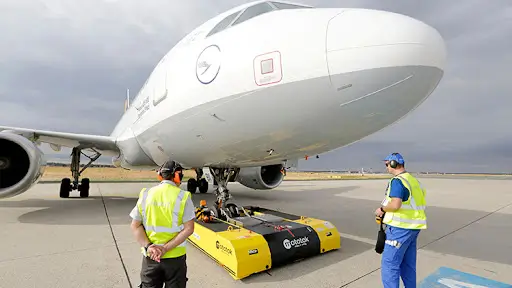Imagine this enormous aircraft, a marvel of contemporary engineering, gliding into its assigned gate. The reality is far more complicated, despite appearances to the contrary. The airplane tug, an unsung hero of aviation ground operations, is responsible for this seemingly straightforward action. These sturdy vehicles, which are sometimes disregarded, are essential to the seamless and effective coordination of airplanes on the ground. Let’s explore the interesting world of aircraft tugs and learn about their vital role in the aviation industry.
The Power Behind Ground Movement:
To put it simply, an airport tug is a specially designed car meant to tow aircraft. This is accomplished by using a tow bar or a more advanced tow-barless system to secure the tug to the aircraft’s nose landing gear. After the aircraft is linked, the tug operator expertly maneuvers it through the intricate system of taxiways to guarantee exact placement at the assigned gate or parking space. This seems like a simple task, but it takes careful planning and experience to protect the plane and the ground crew.
Power and Accuracy in Towing:
It is important to think about the force of an aircraft tug. A great deal of torque and traction are required by these heavy-duty trucks because they can effortlessly haul airplanes weighing hundreds of tons. The tug’s engine, typically powered by diesel, generates the thrust required to overcome the aircraft’s inertia and propel it ahead. However, precision is also necessary for this tremendous force. The aircraft’s delicate landing gear is particularly vulnerable to damage; thus, tug operators must use considerable caution and precision to prevent accidents.
Multiple Tug Setups:
Aircraft tugs come in a variety of forms, each painstakingly made to meet the needs of particular aircraft types and operational requirements. Towbar tugs, another name for conventional tugs, depend on a tow bar to connect to the aircraft. These tugs are well-known for their adaptability and extensive use in the aviation sector. In contrast, towbarless tugs offer a more efficient and streamlined alternative. They do not require a tow bar since they use a specific system to hold the nose landing gear directly. Because of their remarkable mobility, towbarless tugs are especially well-suited for narrow-body aircraft.
Technological Developments in Tugs:
The steadfast pursuit of greater environmental sustainability, safety, and efficiency has propelled tug technology through a period of substantial change. These days, state-of-the-art tugs have intricate control panels, electronic steering, and anti-lock braking systems to guarantee top performance and control. To take it a step further, some tugs use electric or hybrid propulsion systems, which significantly cut down on noise and pollutants, further making the aircraft industry more eco-friendly. Additionally, the advent of remote-controlled tugs has revolutionized ground operations by enabling operators to remain at a safe distance while still enforcing safety protocols.
Various Uses of Tugs
Although tugs are most commonly used for towing aircraft, they are indispensable for a wide variety of other ground-handling operations. Pushing the planes away from the gate allows them to continue with the pre-takeoff procedure. Also, when the weather is bad, tugs help move the planes around the maintenance hangars and to the de-icing facilities. Additionally, tugs are essential for removing planes from taxiways and runways in the case of unexpected disasters. Here, one sees the critical role of tugs in an emergency.
Recognizing the Essential Function of Tugs in Aviation
Although aircraft tugs are essential to the efficient running of airports, they receive very little notice from the general public. Even so, their importance in keeping airports safe and efficient for passengers cannot be overlooked. Aircraft on the ground would have a much more difficult time moving around without tugs, which could cause delays, interruptions, and risks to safety. Aircraft tugs are one of the best inventions of the modern world.
Conclusion
Aircraft tugs facilitate the smooth and efficient transportation of airplanes on the ground. They are very valuable assets to the aviation environment due to their strength, precision, and adaptability. As technology advances, you can anticipate more advanced evolutions in tug design that prioritize increased efficiency, safety, and awareness of environmental impact. The next time you see an aircraft gracefully tucking into its gate, take a moment to appreciate the little pull that enabled it to happen.





